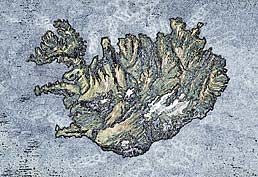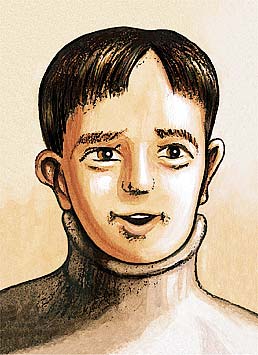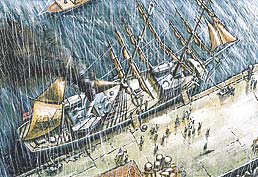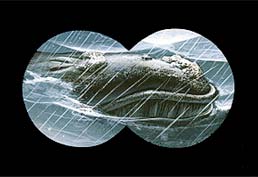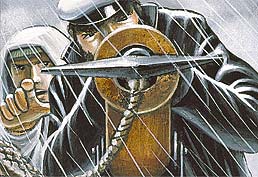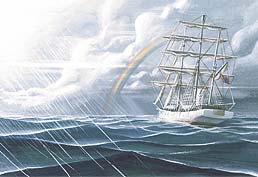|
|
||||||||||||||||||||||||||||||||||||||||||||||||||||||||||||||||||||||||||||||||||||||||||
 |
|
|||||||||||||||||||||||||||||||||||||||||||||||||||||||||||||||||||||||||||||||||||||||||
To
call the story of “Jónas Blondal” a comic, is
actually not quite suitable. The word “comic” is derived
from “comedy”, but “Jónas Blondal” is anything
but comical. It is a sad, serious story with a moral to it. The
term “tragedic” would therefore be more accurate. The Atlantic island of Iceland and its inhabitants form the historical and cultural background of this story. On the threshold of the 20th century Iceland experienced a
period of increased independence – for many inhabitants a
positive development after centuries of suffering and oppression.
Yes, the Icelanders had indeed lived through very gloomy times. The situation eased temporarily due to successful business relations with England and the Hanseatic League, but restraint on trade imposed by the Danish in 1622 aggravated the situation considerably again. Unscrupulousness, inadequate provisions, and exploitation of the population even led to the death of more than 1000 people in 1755/56 from starvation. But that’s not all. In the history of Iceland catastrophes of a different kind claimed countless lives time and again. Only a few decades after the outbreak of smallpox in 1347, the plague caused havoc between 1402 and 1404 and killed 40,000 to 50,000 people – no less than two thirds of the entire population. Severe winters, volcanic eruptions and repeated raids by foreign sailors also claimed their toll on human lives. With the advent of the struggle for independence during the middle
of the 19th century, Iceland’s situation improved rapidly.
The most prominent forerunner in this struggle was Jón Sigurðsson,
who for the most part lived in Denmark. Finally in 1874 the “Althing”,
the people’s assembly of Iceland, agreed to a constitution,
which would grant more self-determination to the Icelanders. On
17th June 1944, Iceland gained final independence as a democratic
republic. The time is 1894 and the place is Reykjavík, in those days a town with almost 5800 inhabitants. In Eiríksgata, not far from the harbour lives a family called Blondal, descendants of Norwegian immigrants. Amalie and Ivar Blondal originally had three sons: Sigurð, Grímur and Jónas. However, at the beginning of this story two of them are already dead. The eldest son, Sigurð, drowned in 1881 during a boating accident at the tender age of eight. Grímur, the second son, died of a serious illness at the age of 15. The story begins with his funeral. Jónas, born in 1882 and now twelve years old, is therefore the Blondals only remaining child. Straight after the funeral, while the mourners are still at the wake, a bitter quarrel flares up between the couple. The bone of contention is none other than their son Jónas: Ivar Blondal, a very successful whaler for many years, for the first time that evening makes the request that at least one of his sons should learn his trade. This is what tradition demands – even if there is only the youngest son left. Ivar is aware, that Jónas has not reached the right age yet but, nevertheless, he plans to take him on his next journey. Of course, Jónas is very enthusiastic about his father’s idea, but his mother protests. She accuses her husband of being irresponsible and indifferent. Never would she expose her last remaining son to unnecessary dangers. Although she puts up a fight, she does not succeed in changing his mind. As agreed, on 5th June 1894 father and son turn up at the local seamen’s employment office in Vesturgata. Again, Ivar Blondal is unimpressed when the clerk voices reservations about taking a twelve-year old on the trip. As planned, Ivar and Jónas sign on for the “Eiríkur Rauði”, a whaler moored in Reykjavík but sailing under the Norwegian flag. 13th July 1894: The day of departure has arrived. Soon Jónas
is given simple tasks to perform on board, and the days pass without
any unusual occurrences. After only three days the “Eiríkur
Rauði” hits on a pod of whales. For the first time Jónas
experiences for himself, what up to then he had only known from
the thrilling accounts of this father: the catching and processing
of a whale. Pure adventure – at least that’s what
he had thought up to this moment. But his childish imaginations
have nothing to do with the harsh reality of this profession. Blood
everywhere, shouting men and a nauseating smell. In the coming days
Jónas repeatedly has to witness these scenes, but he finds
it impossible to get used to them. On the contrary, with every new
successful catch, his aversion to the events on board grows. His
excitement gives way to thoughtfulness, and his thirst for adventure
turns into compassion for the helpless creatures. With these words the comic begins – and so it ends. “Jónas Blondal” is not just a story about a young boy from Iceland. It is a story about whaling and the ethical questions it raises. With a such a serious theme, the story is not intended to be entertaining or amusing. True, a story without a happy ending does not follow the popular recipe for success. And with regard to stories of purely entertaining value a sad ending might even prove to be a hindrance. But when a story has a documentary character, the message is emphasised all the more. Successful stories like “The Boat” (filmed in 1981, adapted from the novel by Lothar-Günther Buchheim) or “Awakenings” (adapted from the novel of the same name by Oliver Sacks, filmed 1990) show this very clearly. Other examples are, “Rain Man” (written by Ronald Bass and Barry Morrow, filmed in 1988) or “The Perfect Storm” (novel by Sebastian Junger, filmed 2000). “Jónas Blondal” has a documentary character.
Whether this story can succeed without a happy ending, is up to
the individual reader. Of course, a tragic finale often leaves the
reader with an unsatisfactory feeling of helplessness and disappointment.
However, deep stories have a more profound effect on the mind than
entertainment of the more trivial kind. “Jónas Blondal”
gives food for thought. An examination of the subject of whaling
deserves seriousness (please also note about the
story › comic’s message). |
|
|||||||||||||||||||||||||||||||||||||||||||||||||||||||||||||||||||||||||||||||||||||||||
